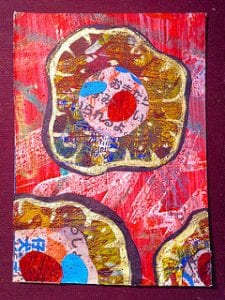Scientist diagnose cancerous cells using a set of predetermined criteria. As a practicing cytologist for over a decade, I used certain characteristics to determine if a cell was benign or malignant.
Parameters such as presence of a nucleolus and or mitotic figures, nucleus to cell ratio, cytoplasm pigmentation and or irregular arrangement were the most common identifying characteristics of a tumour cell. If these markers were detected within a cell or among similar cells in a sample, then a report written up and a diagnosis made.
Now as a teacher librarian, I use predetermined criteria to determine which resources to add to the collection. These predetermined criteria are listed in the collection development policy so I do not have to come up with them, but rather I have to apply them to the books, magazines, ebooks and multimedia that flow into our information centre.
Selection in the school, are professional concepts that guide T/Ls to what resources are appropriate to the school collection that meet the teaching and learning needs of the school community. Unlike public libraries, school libraries have to also meet curriculum demands. To put it bluntly, in a school context, the needs and requirements of a school community are the driving force for resource selection.
So whilst I was contemplating this fact, I then thought about what selection criteria I would create. Whilst I agree with Hughes-Hassell & Mancall (2005) with the criteria present in their diagram, I disagree with the idea of a flow chart, as not every resource will follow all steps and thus even great resources could be excluded. This is especially true for high school libraries where often specialist information may be required for niche teaching and learning contexts.
The criteria I came upon was loosely based to the criteria in Hughes-Hassell & Mancall (2005) flow chart but I had four general categories with sub sections. Resources do not have to match all the specific criteria, but must fulfill the major ones of teaching and learning needs; curriculum needs; school requirements and school ethos. This system will give more flexibility to the TL in creating a school collection that is balanced yet addressing the needs of the community.
Selection Criteria – My way.
- Teaching and learning needs
- Resources are of high quality and appropriate. Have authority, accuracy, validity and currency.
- Meets scope of learning needs and styles – including recreational reading
- Integrates digital technologies ie multimodal resources in print, media, audio and ebooks that enrich T&L
- Curriculum needs
- Provides information about curriculum content
- Addresses other curriculum requirements ie cross curricular priorities, capabilities and learning outcomes.
- Challenges thinking about past, current and future global issues.
- School needs
- Supported by current IT network and library management system
- Cost efficient
- Consistent with the values of the school
- Consistent with the values of love, compassion and respect.
- Acknowledge diversity of religion, ethnicity and languages.
I included a subsection on challenging thinking on past, present and future global issues’, because of the framework decided by the MCEETYA (2008) . The policy desires that “All young Australians (are to) become successful learners, confident and creative individuals (and) active and informed citizens”. It is a personal belief, but in order for students to become the active and informed citizens that our society needs, they need to be able to critically analyse and evaluate the maelstrom of information that besiege them constantly. They need to be able to seek and use information critically and ethically.
Maybe we should be structuring our selection criteria based on what we want our learners to be. Active, engaged citizens who are able to seek and use information as well as think critically and logically, and who are able to make informed opinions. I wonder how that selection criteria will look
Hughes-Hassell, S., & Mancall, J. C. (2005). Collection management for youth : Responding to the needs of learners. Retrieved from https://ebookcentral.proquest.com
MCEETYA (2008) Melbourne Declaration on Educational Goals for Young Australians. Curriculum Corporation. Australia. Retrieved from http://www.curriculum.edu.au/verve/_resources/national_declaration_on_the_educational_goals_for_young_australians.pdf

